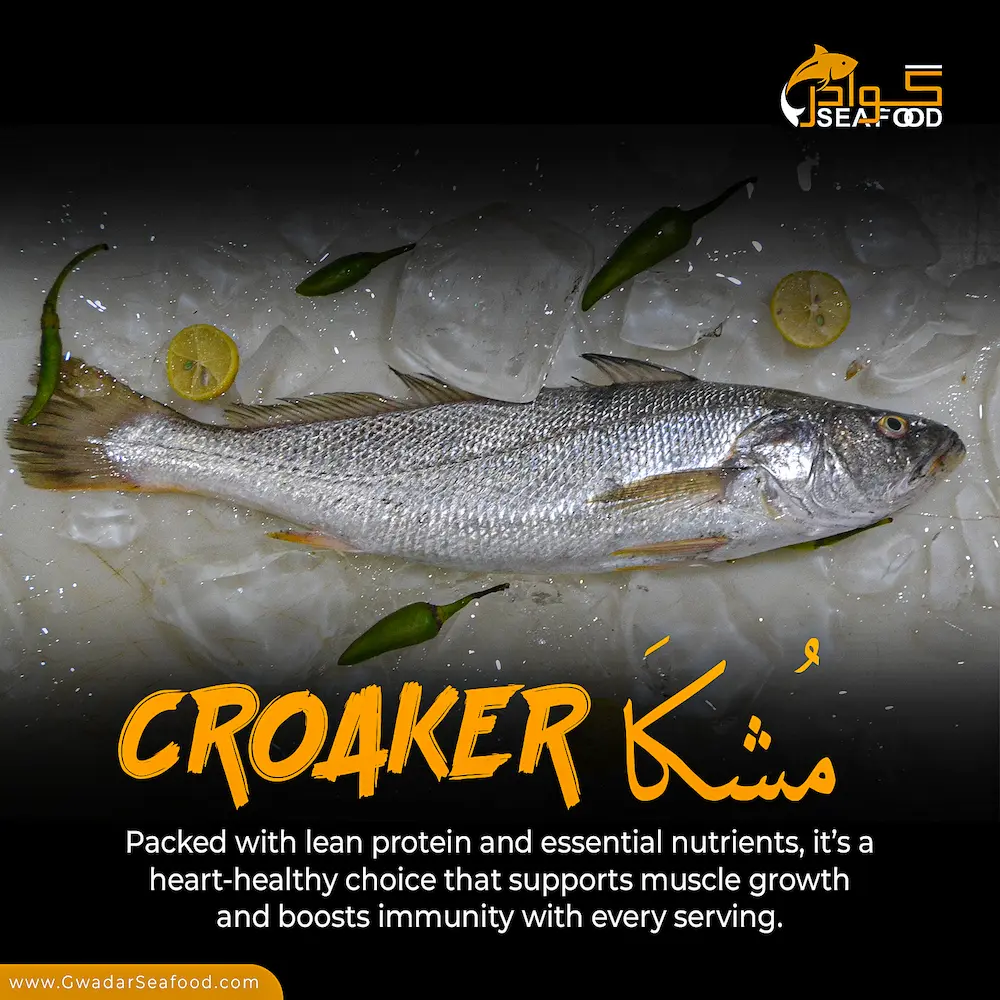Introduction
Croaker, known locally as Mushka in Pakistan, is a medium-sized fish from the Sciaenidae family, recognized for its mild, delicate flavor and soft, flaky texture. Mushka is a popular choice for various culinary dishes in South Asia and beyond. What makes it even more interesting is its unique ability to absorb spices and flavors, making it ideal for flavorful curries and grilled dishes.
One important aspect of Croaker is its swim bladder (fish maw). While its maw is valuable, it is cheaper compared to Bengal Corvina, another member of the Sciaenidae family. Croaker and Bengal Corvina look quite similar, but can be distinguished by their appearance:
-
Croaker (Mushka): Shiny white body, firm and fit structure.
-
Bengal Corvina: Slightly yellowish body with a fuller, fatty appearance.
Adding to this family resemblance is the Japanese Meagre (Sua), often considered the most prized species due to its extremely expensive maw. In fact, Sua’s maw is so valuable that many are sold gutted—after the maw is collected—rather than whole. Japanese Meagre grows larger than both Croaker and Bengal Corvina, making it a premium catch in the seafood market.
What Is Fish Maw?
Fish maw refers to the dried swim bladder of certain fish species, including Croaker. This gelatinous organ aids the fish in maintaining buoyancy and is valued for its health benefits and texture in high-end culinary applications, especially in Chinese cuisine.
Habitat, Diet & Growth
Croaker is primarily found in the shallow coastal waters of the Arabian Sea, specifically along the coasts of Sindh and Balochistan. These fish thrive in sandy or muddy estuaries and river mouths, where they feed on small fish, crustaceans, and plankton. Their diet ensures they grow rapidly, reaching maturity in 2-3 years.
-
Habitat: Shallow coastal zones, river mouths, and estuaries.
-
Feeding: Bottom feeders that consume small fish, crustaceans, and plankton.
-
Migration: Moves seasonally, mostly for breeding and feeding, particularly during the monsoon season (June to September).
Spawning & Conservation
Croakers spawn during the monsoon season, releasing a vast number of eggs into the ocean’s currents. Although the population of Croaker is currently stable, it is crucial to implement sustainable fishing practices to ensure long-term availability and reduce the risk of overfishing.
-
Spawning Season: June to September (monsoon).
-
Egg Production: Up to 500,000 eggs per female per cycle.
-
Conservation Status: Least Concern. Croaker populations are monitored to ensure sustainability.
Why Croaker (Mushka) Is Worth a Try
-
Mild Flavor: Croaker is perfect for those who prefer light, delicate-tasting seafood. It absorbs the spices in curries and marinades, making it versatile for various cooking methods.
-
Firm & Flaky Texture: The flesh holds up well to grilling, frying, or even simmering in curries.
-
Nutritional Value: Rich in protein and omega-3 fatty acids, making it an excellent choice for health-conscious consumers.
-
Affordability: A cost-effective seafood option, offering great value without compromising on flavor or nutritional benefits.
-
Culinary Delights: Known for its ability to enhance the taste of both traditional and modern dishes.
Names & Taxonomy
English Name: Tigertooth Croaker, Croaker
Local Name (Urdu): Mushka (مشکا)
Scientific Name: Otolithes ruber
Family: Sciaenidae
Order: Acanthuriformes
Class: Actinopterygii
Phylum: Chordata
Sourcing & Catching Method
Croaker is wild-caught in the Arabian Sea, specifically off the coasts of Karachi and Balochistan. The fish is captured using sustainable fishing methods such as gillnets and purse seines, ensuring minimal bycatch and maintaining the fish’s high quality. The fish is processed and cleaned on the same day, without any chemical dips or freezing, ensuring its freshness when it reaches your table.
-
Fishing Method: Gillnets and purse seines.
-
Season: Available year-round, especially abundant during the monsoon season (June-September).
Physical Traits & Texture
Croaker has an oval, streamlined body designed for efficient swimming. Its shiny, silvery skin may have a slight yellowish tint near the tail. The flesh is white, firm, and flaky with a mild oceanic flavor that holds up well during grilling, frying, or curries. Croaker’s bones are small and manageable, especially when cut into fillets or steaks, making it an easy-to-eat fish.
Size Options
Croakers generally range in size from 0.5 kg to 3 kg, though larger specimens may occasionally be found. It is available as whole fish, steaks, or fillets to suit different culinary needs.
Cutting Options & Approximate Yields
| Cut Style | Yield | Ideal Use |
|---|---|---|
| Whole (cleaned) | ~100% | Grilling, roasting, full fry |
| Gutted only | ~85% | Curries, masala fry |
| Headless & Gutted | ~70% | Fry prep, BBQ |
| Sliced (bone-in) | ~65% | Tawa fry, pan-sear, masala |
| Boneless Fillets | ~45% | Fish cakes, grilling |
Cooking Ideas – Versatile, Rich & Flavorful
-
Karachi-style Mushka Fry: Marinate with red chili, garlic, and lemon juice, then shallow fry for a crispy, spicy treat.
-
Mushka Masala Curry: Simmer in a rich tomato-onion gravy with garam masala and cilantro for a comforting curry.
-
Tandoori Mushka: Marinate with yogurt, cumin, and paprika, then grill to perfection for a smoky flavor.
-
Grilled Whole Fish: Coat with a cumin-coriander paste and grill for a smoky crust.
-
Bengali Mustard Curry: Mustard paste and kalonji for a tangy, spicy dish that pairs perfectly with rice.
Tips for Selecting Fresh Croaker (Mushka)
-
Eyes: Clear and bright, with no cloudiness.
-
Skin: Shiny, intact, and silver, without discoloration.
-
Flesh: Firm and bouncy when pressed.
-
Smell: Fresh, ocean-like scent, no pungent fishy odor.
Storage Tips
-
Refrigeration: Store below 4°C and consume within 2 days for maximum freshness.
-
Freezing: Store in airtight containers for up to 1 month for extended freshness.
-
Marinated Storage: Freeze raw marinated slices and cook directly from the freezer for convenience.
Nutrition Highlights (Approx. per 100g, steamed or grilled)
| Nutrient | Amount |
|---|---|
| Calories | ~104 kcal |
| Protein | ~18 g |
| Total Fat | ~3.2 g |
| Saturated Fat | ~1.1 g |
| Monounsaturated Fat | ~1.1 g |
| Polyunsaturated Fat | ~0.46 g |
| Carbohydrates | 0 g |
| Sodium | ~56 mg |
| Calcium | ~15 mg |
| Iron | ~0.37 mg |
| Magnesium | ~40 mg |
| Phosphorus | ~210 mg |
| Potassium | ~345 mg |
| Zinc | ~0.42 mg |
| Copper | ~0.04 mg |
| Manganese | ~0.03 mg |
| Selenium | ~37 µg |
| Vitamin B12 | ~2.1 µg |
| Vitamin D | ~0.7 µg |
Need Something Similar?
-
Japanese Meagre (Sua)

 Sea Fish
Sea Fish

Reviews
There are no reviews yet.